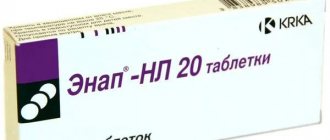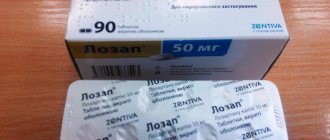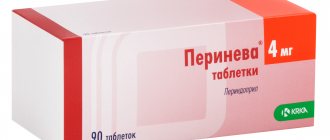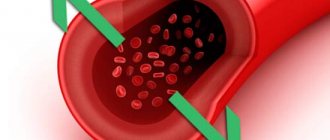Pharmacodynamics and pharmacokinetics
Pharmacodynamics
Micardis Plus is a combination of telmisartan angiotensin type II receptor blocker hydrochlorothiazide ( diuretic ). The combined use of these components causes a stronger antihypertensive effect than using them separately. Taking the drug once a day leads to a pronounced gradual decrease in blood pressure.
Telmisartan is a selective angiotensin type 2 receptor blocker. Has high affinity for angiotensin II receptors of the AT1 subtype . It displaces angiotensin II from the receptor. The binding is long-term. Telmisartan does not block other receptors (including AT2 type receptors) of angiotensin . Telmisartan also reduces aldosterone .
In persons with arterial hypertension 80 mg of telmisartan per day completely suppresses the effects of angiotensin II . The onset of action occurs three hours after ingestion of the drug. The effect lasts for 24 hours. A permanent antihypertensive effect is observed a month after regular use of telmisartan .
Hydrochlorothiazide is diuretic . Affects the reabsorption of electrolytes in the renal tubules, directly increasing the excretion of sodium and chlorides. This causes a decrease in circulating blood volume, an increase in renin aldosterone synthesis .
After administration of hydrochlorothiazide, diuresis increases after two hours, and the maximum effect is achieved after four hours and persists for 6-12 hours.
Pharmacokinetics
Telmisartan. Quickly absorbed from the digestive tract. The maximum concentration of telmisartan occurs within an hour. Bioavailability is 50%.
Reaction with blood proteins is more than 99.5%. Metabolized by interaction with glucuronic acid . Telmisartan derivatives are pharmacologically inactive.
The half-life is approximately 20 hours. Excreted with feces in its original form and with the kidneys - up to 2%.
The pharmacokinetics of telmisartan in elderly patients does not differ from those in younger patients. No dose selection is required.
Hydrochlorothiazide. After oral administration of hydrochlorothiazide, maximum concentrations are achieved within 1-2 hours. Bioavailability reaches 60%.
Reaction with plasma proteins – 64%. It is not metabolized and is excreted unchanged through the kidneys.
MicardisPlus®
HYDROCHLOROTHIAZIDE
Renal dysfunction
In patients with impaired renal function, hydrochlorothiazide may cause azotemia. In case of renal failure, accumulation of hydrochlorothiazide is possible.
In patients with reduced renal function, periodic monitoring of creatinine clearance is necessary. If renal dysfunction progresses and/or oliguria (anuria) occurs, hydrochlorothiazide should be discontinued.
Liver dysfunction
When using thiazide diuretics in patients with impaired liver function, hepatic encephalopathy may develop. In patients with severe liver failure or hepatic encephalopathy, the use of thiazides is contraindicated. In patients with mild to moderate hepatic impairment and/or progressive liver disease, hydrochlorothiazide should be used with caution, since even slight changes in fluid and electrolyte balance and serum ammonium accumulation can cause hepatic coma. If symptoms of encephalopathy occur, diuretics should be discontinued immediately.
Water-electrolyte balance and metabolic disorders
Thiazide diuretics (including hydrochlorothiazide) can cause a decrease in the volume of circulating fluid (hypovolemia) and disturbances in water and electrolyte balance (including hypokalemia, hyponatremia, hypochloremic alkalosis). Clinical symptoms of fluid and electrolyte imbalance are dry mouth, thirst, weakness, lethargy, fatigue, drowsiness, restlessness, muscle pain or cramps, muscle weakness, marked decrease in blood pressure, oliguria, tachycardia, arrhythmia and gastrointestinal disorders (such as nausea and vomiting). In patients receiving hydrochlorothiazide therapy (especially with long-term course treatment), clinical symptoms of fluid and electrolyte imbalance should be identified and blood electrolyte levels should be regularly monitored.
Sodium
All diuretics can cause hyponatremia, sometimes leading to severe complications. Hyponatremia and hypovolemia can lead to dehydration and orthostatic hypotension. A concomitant decrease in chlorine ions can lead to secondary compensatory metabolic alkalosis, but the frequency and severity of this effect are insignificant. It is recommended to determine the content of sodium ions in the blood plasma before starting treatment and regularly monitor this indicator while taking hydrochlorothiazide.
Potassium
When using thiazide and thiazide-like diuretics, there is a risk of a sharp decrease in the potassium content in the blood plasma and the development of hypokalemia (potassium concentration less than 3.4 mmol/l). Hypokalemia increases the risk of developing heart rhythm disturbances (including severe arrhythmias) and enhances the toxic effect of cardiac glycosides. In addition, hypokalemia (as well as bradycardia) is a condition that contributes to the development of polymorphic ventricular tachycardia of the “pirouette” type, which can be fatal.
Hypokalemia poses the greatest danger to the following groups of patients: elderly people, patients simultaneously receiving therapy with antiarrhythmic and non-antiarrhythmic drugs that can cause polymorphic ventricular tachycardia of the "pirouette" type or increase the duration of the QT interval on the ECG, patients with impaired liver function, coronary heart disease , chronic heart failure. In addition, patients with an increased QT interval are at increased risk. It does not matter whether this increase is caused by congenital causes or the effect of drugs. In all the cases described above, it is necessary to avoid the risk of developing hypokalemia and regularly monitor the potassium content in the blood plasma. The first measurement of the content of potassium ions in the blood must be carried out within the first week from the start of treatment. If hypokalemia occurs, appropriate treatment should be prescribed. Hypokalemia can be corrected by using potassium-containing medications or eating foods rich in potassium (dried fruits, fruits, vegetables).
Calcium
Thiazide diuretics may reduce the excretion of calcium ions by the kidneys, leading to a slight and temporary increase in plasma calcium levels. In some patients, with long-term use of thiazide diuretics, pathological changes in the parathyroid glands were observed with hypercalcemia and hyperphosphatemia, but without the typical complications of hyperparathyroidism (nephrolithiasis, decreased bone mineral density, peptic ulcer). Severe hypercalcemia may be a manifestation of previously undiagnosed hyperparathyroidism. Because of their effect on calcium metabolism, thiazides may interfere with laboratory parameters of parathyroid function. Thiazide diuretics (including hydrochlorothiazide) should be discontinued before testing parathyroid function.
Magnesium
Thiazides have been found to increase renal excretion of magnesium, which can lead to hypomagnesemia. The clinical significance of hypomagnesemia remains unclear.
Glucose
Treatment with thiazide diuretics may impair glucose tolerance. When using hydrochlorothiazide in patients with manifest or latent diabetes mellitus, it is necessary to regularly monitor the concentration of glucose in the blood. Dosage adjustment of hypoglycemic medications may be required.
Uric acid
In patients with gout, the frequency of attacks may increase or the course of gout may worsen. Careful monitoring of patients with gout and impaired uric acid metabolism (hyperuricemia) is necessary.
Lipids
When using hydrochlorothiazide, the concentration of cholesterol and triglycerides in the blood plasma may increase.
Choroidal effusion, acute myopia and secondary angle-closure glaucoma
Hydrochlorothiazide, a sulfonamide, can cause an idiosyncratic reaction resulting in choroidal effusion with visual field defects, acute transient myopia, and acute angle-closure glaucoma. Symptoms include: sudden loss of visual acuity or eye pain, usually occurring within hours to weeks of starting hydrochlorothiazide therapy. If left untreated, acute angle-closure glaucoma can lead to irreversible vision loss. If symptoms appear, you should stop taking hydrochlorothiazide as soon as possible. If intraocular pressure remains uncontrolled, emergency medical treatment or surgery may be required. Risk factors for the development of acute angle-closure glaucoma are a history of allergic reactions to sulfonamides or penicillin.
Immune system disorders
There are reports that thiazide diuretics (including hydrochlorothiazide) may cause exacerbation or progression of systemic lupus erythematosus, as well as lupus-like reactions. In patients receiving thiazide diuretics, hypersensitivity reactions may occur even in the absence of a history of allergic reactions or bronchial asthma.
Photosensitivity
There is information about cases of the development of photosensitivity reactions when taking thiazide diuretics. If photosensitivity occurs while taking hydrochlorothiazide, treatment should be discontinued. If continued use of the diuretic is necessary, the skin should be protected from exposure to sunlight or artificial ultraviolet rays.
Non-melanoma skin cancer
Two pharmacoepidemiological studies using data from the Danish National Cancer Registry demonstrated an association between hydrochlorothiazide use and an increased risk of non-melanoma skin cancer (NMSC) basal cell carcinoma and squamous cell carcinoma. The risk of developing NMSC increased with increasing total (cumulative) dose of hydrochlorothiazide. A possible mechanism for the development of NMSC is the photosensitizing effect of hydrochlorothiazide.
Patients taking hydrochlorothiazide as monotherapy or in combination with other drugs should be aware of the risk of developing NMSC.
It is recommended that such patients undergo regular skin examination to identify any new suspicious lesions as well as changes in existing skin lesions.
Any suspicious skin changes should be reported to your doctor immediately. Suspicious areas of skin should be examined by a specialist. To clarify the diagnosis, histological examination of skin biopsies may be required.
To minimize the risk of developing NMSC, patients should be advised to follow preventive measures, such as limiting exposure to sunlight and UV rays, and using appropriate protective equipment. In patients with a history of non-melanoma skin cancer, it is recommended to reconsider the use of hydrochlorothiazide.
Alcohol
During the treatment period, it is not recommended to drink alcoholic beverages, because ethanol enhances the antihypertensive effect of thiazide diuretics.
Doping control
Hydrochlorothiazide may give a positive result during doping control in athletes.
Other
In patients with severe atherosclerosis of the cerebral and coronary arteries, hydrochlorothiazide should be used with extreme caution.
Thiazide diuretics can reduce the amount of iodine bound to plasma proteins without causing signs of thyroid dysfunction
TELMISARTAN
Conditions that increase the activity of the RAAS
In some patients, due to suppression of the activity of the RAAS, especially with the simultaneous administration of drugs acting on this system, renal function is impaired (including acute renal failure). Therefore, therapy accompanied by such a double blockade of the RAAS (for example, by adding an angiotensin-converting enzyme inhibitor (ACEI) or a direct renin inhibitor - aliskiren to angiotensin II receptor antagonists) should be carried out strictly individually and with regular monitoring of renal function, including periodic monitoring of blood levels potassium and creatinine in the blood serum (see section “Contraindications”).
The simultaneous use of angiotensin II receptor antagonists with drugs containing aliskiren is contraindicated in patients with diabetes mellitus and/or with moderate or severe renal impairment (GFR less than 60 ml/min/1.73 m2 body surface area) and is not recommended in other patients. Concomitant use of angiotensin II receptor antagonists with ACE inhibitors is contraindicated in patients with diabetic nephropathy and is not recommended in other patients (see section "Contraindications").
Renovascular hypertension
In patients with bilateral renal artery stenosis or arterial stenosis of a single functioning kidney, the use of drugs that affect the RAAS increases the risk of developing severe arterial hypotension and renal failure.
Liver dysfunction
In patients with impaired liver function or progressive liver diseases, MicardisPlus® should be used with caution, since even slight changes in the water and electrolyte balance can contribute to the development of hepatic coma.
Diabetes
In patients with diabetes mellitus and an additional cardiovascular risk, for example, in patients with diabetes mellitus and coronary artery disease (CAD), when using drugs that lower blood pressure, such as angiotensin II receptor antagonists (ARA II) or ACE inhibitors, The risk of fatal myocardial infarction and sudden cardiovascular death may be increased. In patients with diabetes mellitus, CAD may be asymptomatic and therefore may be undiagnosed. In patients with diabetes mellitus, before starting the use of MicardisPlus®, appropriate diagnostic studies, including an exercise test, should be carried out to identify and treat coronary artery disease.
Acute myopia and secondary angle-closure glaucoma
Hydrochlorothiazide, being a sulfonamide derivative, can cause an idiosyncratic reaction in the form of acute transient myopia and acute angle-closure glaucoma. Symptoms of these disorders include a sudden decrease in visual acuity or eye pain, which typically occurs within a few hours to several weeks after starting to use the drug. If left untreated, acute angle-closure glaucoma can lead to vision loss. The main treatment is to discontinue hydrochlorothiazide as quickly as possible. It is important to keep in mind that if intraocular pressure remains uncontrolled, emergency medical or surgical treatment may be required. Risk factors for the development of acute angle-closure glaucoma include a history of allergies to sulfonamides or penicillin.
In patients with coronary heart disease, the use of any antihypertensive drug, in case of excessive reduction in blood pressure, can lead to myocardial infarction or stroke.
Liver dysfunction when prescribed telmisartan was observed in most cases in Japanese residents.
MicardisPlus® is less effective in patients of the Black race.
Contraindications
The drug has the following contraindications:
- obstruction of the biliary tract;
- severe liver or kidney dysfunction;
- refractory hypercalcemia, hypokalemia ;
- fructose intolerance ;
- lactase deficiency galactose or lactose intolerance ;
- age less than 18 years;
- lactation;
- pregnancy;
- allergy to the components of the drug.
Carefully:
- stenosis of both renal arteries, severe kidney damage;
- liver dysfunction or progressive liver damage;
- hyperkalemia;
- hypovolemia after treatment with diuretics , as well as after limiting salt intake, vomiting or diarrhea ;
- chronic heart failure , functional class III-IV;
- mitral and aortic valve ;
- condition after kidney transplant;
- obstructive cardiomyopathy;
- primary aldosteronism ;
- diabetes;
- gout.
Side effects
- From the respiratory system: shortness of breath, respiratory distress syndrome .
- From the circulatory system: tachycardia , arrhythmias , bradycardia , severe decrease in blood pressure.
- From the nervous system: fainting, paresthesia , dizziness, insomnia , anxiety, depression , excitability, headache.
- From the digestive system: flatulence, diarrhea, dry mouth, abdominal pain, constipation, gastritis, hypercholesterolemia, hyperglycemia, pancreatitis, jaundice, dyspepsia.
- Skin: sweating.
- From the musculoskeletal system: muscle spasms, arthralgia , myalgia , arthrosis , chest pain.
- From the hematopoietic system: leukopenia, eosinophilia, anemia, neutropenia, thrombocytopenia, thrombocytopenia.
- From the genitourinary system: renal failure, nephritis, glucosuria.
- From the eyes: visual impairment, glaucoma, xanthopsia, acute myopia .
- Infections: sepsis , respiratory tract infections ( pharyngitis, bronchitis, sinusitis ), inflammation of the salivary glands.
- Metabolic disorders: increased creatinine, liver enzymes, creatine phosphokinase, uric acid in the blood, hypertriglyceridemia, hyperkalemia, hypokalemia, hypoglycemia, hyponatremia, decreased hemoglobin .
- Allergic reactions : skin itching, angioedema , rash, erythema , anaphylactic reactions , eczema, systemic vasculitis, necrotizing vasculitis .
MIKARDIS PLUS tab. 80+12.5 mg No. 28
Side effects
1) - side effects expected based on experience with telmisartan.
2) - side effects expected based on experience with hydrochlorothiazide.
From the respiratory system: upper respiratory tract infections (including bronchitis, pharyngitis, sinusitis), shortness of breath1), dyspnea, respiratory distress syndrome (including pneumonia and pulmonary edema)2).
From the cardiovascular system: bradycardia1), tachycardia1), arrhythmias2), marked decrease in blood pressure1), orthostatic hypotension2), necrotizing angiitis (vasculitis)2), chest pain1).
From the side of the central nervous system: excitability, fear, depression1)2), anxiety2), dizziness, fainting1), insomnia1), staggering when walking2), paresthesia2).
From the digestive system: abdominal pain, diarrhea, dyspepsia, gastritis, anorexia2), loss of appetite2), sialadenitis2), dry mouth1), flatulence1), vomiting1), constipation2), pancreatitis2), impaired liver function1), jaundice (hepatocellular or cholestatic)2).
From the endocrine system: loss of control of hypoglycemia in diabetes mellitus.
Metabolic disorders: hypercholesterolemia, hyperuricemia, hypokalemia, hyperkalemia, hyponatremia2), decrease in blood volume2), disturbance of electrolyte metabolism2), hyperglycemia2), hypercalcemia1).
From the hematopoietic system: eosinophilia1), anemia (including aplastic anemia2), hemolytic anemia2), inhibition of bone marrow hematopoiesis2), leukopenia2), neutropenia/agranulocytosis2), thrombocytopenia1)2).
From the urinary system: urinary system infections, interstitial nephritis2), impaired renal function2), acute renal failure1), glycosuria2).
From the musculoskeletal system: arthralgia, arthrosis, back pain, pain in the legs, myalgia, convulsive twitching of the calf muscles (cramps)1), symptoms similar to tendinitis1), weakness1)2), muscle spasm2).
Allergic reactions: anaphylactic reactions2), eczema, erythema1), itching1), cutaneous lupus-like reactions2), cutaneous vasculitis2), photosensitivity reactions2), rash2), reactivation of cutaneous lupus erythematosus2), toxic epidermal necrolysis2), angioedema, urticaria and other similar reactions (as is the case with the use of other angiotensin II antagonists).
From the senses: impaired visual acuity1), transient blurred vision2), xanthopsia2), vertigo.
From the reproductive system: decreased potency.
Laboratory indicators: decrease in hemoglobin1), increase in uric acid1), creatinine1), liver enzymes1), blood creatine phosphokinase1), triglycerides2).
Other: flu-like symptoms, fever2), increased sweating1).
The use of thiazide diuretics may impair glucose tolerance.
Interaction
When using telmisartan with:
- other antihypertensive drugs – it is possible to increase the strength of the antihypertensive effect ;
- lithium preparations – a temporary increase in lithium in the blood is possible;
- non-steroidal anti-inflammatory drugs acute renal failure may occur in patients with a reduced volume of circulating blood;
- digoxin – it is possible to increase the concentration of digoxin in the blood by 20%.
When using hydrochlorothiazide with:
- barbiturates, ethanol or opioid orthostatic hypotension may develop ;
- Metformin – possible development of lactic acidosis ;
- hypoglycemic agents and insulin - dose adjustment of hypoglycemic drugs ;
- cholestyramine and colestipol - possible inhibition of hydrochlorothiazide ;
- non-depolarizing muscle relaxants – their effect may be enhanced;
- cardiac glycosides – possible development of hypokalemia or hypomagnesemia ;
- anti-gout medications – it is possible to increase the level of uric acid in the blood.
- calcium preparations – it is possible to increase the concentration of calcium in the blood due to inhibition of its excretion by the kidneys.
- amantadine – there may be an increased risk of developing undesirable effects of amantadine ;
- m-anticholinergic blockers ( atropine , biperiden ) – possible weakening of intestinal motility, increasing the bioavailability of thiazide diuretics ;
- non-steroidal anti-inflammatory drugs - may weaken the diuretic and antihypertensive effects .
special instructions
In patients with coronary heart disease, the use of any blood pressure-lowering drug, in case of a strong decrease in pressure, can lead to the development of myocardial or cerebral infarction.
Micardis Plus has a weaker therapeutic effect in people of the Negroid race.
When driving vehicles, you should be aware of the possibility of dizziness and drowsiness after taking the drug.
Analogues of Mikardis Plus
Level 4 ATX code matches:
Diokor
Gizaar
Teveten Plus
Atacand Plus
Co Diovan
Vazar N
Valz N
The following analogues of the drug are known: Atakand Plus , Valzap Plus , Valsacor , Gizaar Forte , Co-Diovan , Teveten Plus and others.
Micardis analogs
Level 4 ATC code matches:
Telmisartan
Irbesartan
Presartan
Nortivan
Candesartan
Kozaar
Aprovel
Teveten
Blocktran
Cardosal
Valsartan
Losartan
Atakand
Diovan
Valsacor
Vazar
Valz
Lorista
Lorista
Lozap
The most accessible analogues of Mikardis are: Praytor , Telmista , Hipotel .
Price Mikardis Plus
In Ukraine, the price of the drug in a dosage of 80 mg/12.5 mg No. 28 averages 450 hryvnia; in Russia, such a package will cost 855-1000 rubles.
- Online pharmacies in RussiaRussia
- Online pharmacies in UkraineUkraine
ZdravCity
- Mikardis Plus tablets 80 mg + 12.5 mg 28 pcs. Boehringer Ingelheim
RUB 1,111 order
Pharmacy Dialogue
- Mikardis plus (tab. 80 mg/12.5 mg No. 28)Boehringer Ingelheim
1102 rub. order
- Mikardis plus (tab. 80 mg/12.5 mg No. 28)Boehringer Ingelheim
1100 rub. order
show more
Mikardis, instructions for use
According to the instructions for use of Micardis, the drug is taken orally. For adults, the recommended dose is 40 mg once daily. In a number of patients, a therapeutic effect is observed even with a dose of 20 mg per day. If a decrease in pressure to the desired level is not observed, then the dose can be increased to 80 mg per day.
The maximum effect of the drug is achieved five weeks after the start of therapy.
In patients with severe forms of arterial hypertension, 160 mg of the drug per day can be used




